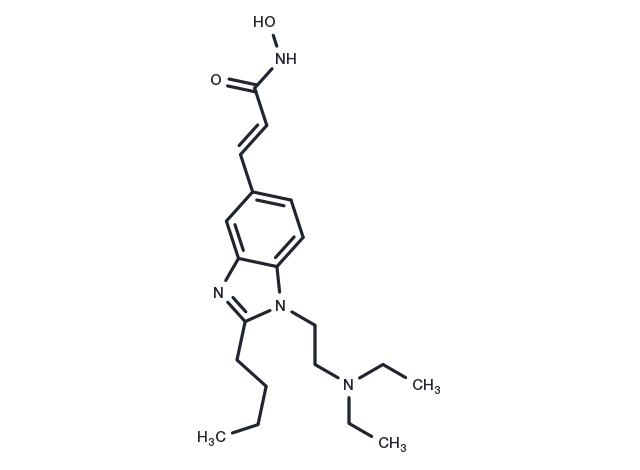Powder: -20°C for 3 years | In solvent: -80°C for 1 year


Pracinostat (SB939) is a novel HDAC inhibitor with improved in vivo properties compared to other HDAC inhibitors currently in Clinicalal trials, allowing oral dosing. Data demonstrate that Pracinostat is a potent and effective anti-tumor drug with potential as an oral therapy for a variety of human hematological and solid tumors.

| Pack Size | Availability | Price/USD | Quantity |
|---|---|---|---|
| 1 mg | In stock | $ 43.00 | |
| 2 mg | In stock | $ 62.00 | |
| 5 mg | In stock | $ 98.00 | |
| 10 mg | In stock | $ 178.00 | |
| 25 mg | In stock | $ 297.00 | |
| 50 mg | In stock | $ 449.00 | |
| 100 mg | In stock | $ 663.00 | |
| 500 mg | In stock | $ 1,390.00 | |
| 1 mL * 10 mM (in DMSO) | In stock | Inquiry |






| Description | Pracinostat (SB939) is a novel HDAC inhibitor with improved in vivo properties compared to other HDAC inhibitors currently in Clinicalal trials, allowing oral dosing. Data demonstrate that Pracinostat is a potent and effective anti-tumor drug with potential as an oral therapy for a variety of human hematological and solid tumors. |
| Targets&IC50 | HDAC1:49 nM, HDAC10:40 nM, HDAC3:43 nM, HDAC5:47 nM, HDAC4:56 nM |
| In vitro | Administered at a dose of 50 mg/kg, SB939 selectively stimulates the growth of CT-116 xenograft tissues. It exhibits a tumor growth inhibition rate of 94% compared to SAHA. In nude mice, SB939 demonstrates superior pharmacokinetics and oral bioavailability than SAHA. Additionally, it inhibits adenoma formation in APC^min mice and enhances hematocrit levels more effectively than 5-fluorouracil. SB939 exhibits anticancer activity and high efficacy in various tumor models, including HCT-116, PC-3, A2780, MV4-11, and Ramos. |
| In vivo | SB939 exhibits selectivity for HDAC over non-HDAC enzymes, receptors, and ion channels that bind zinc by a factor of 100. It significantly inhibits Class II HDAC isoforms including HDAC4, HDAC5, HDAC7, HDAC9, and HDAC10, with IC50 values ranging from 40 nM to 137 nM, but does not affect HDAC6, as demonstrated by its IC50 of 1008 nM. Additionally, SB939 effectively inhibits Class IV enzyme HDAC11, with an IC50 of 93 nM, yet it lacks inhibitory activity against Class III HDACs, specifically SIRT1. Demonstrating significant antiproliferative activity against various tumor cell lines, especially leukemia cells and skin T-cell lymphoma cells, SB939's IC50 values range from 50 nM (in H9 cells) to 170 nM (in HEL92.1.7 cells). |
| Kinase Assay | HDAC enzyme assay: All recombinant HDAC enzymes, with the exception of SIRT1, are cloned and expressed in S*BIO. The reaction mix containing 2.5 or 5 μL of the HDAC isoenzyme, assay buffer (25 mM Tris-HCl, pH 7.5; 137 mM NaCl; 2.7 mM KCl, 1 mM MgCl2 and 1 mg/mL BSA), different concentrations of SB939, and the fluorogenic deacetylase substrate Flour de LysTM in a total reaction volume of 33 μL is incubated at room temperature for 2 hours. 16 μL of Flour de LysTM developer is added and incubated for an additional 10 minutes. The emitted light is measured at 460 nm in a microplate reader. IC50 values are generated using the XLfit software. |
| Cell Research | Cells are seeded in 96-well plates in the log growth phase at a predetermined optimal density, and rested for 24 hours (adherent cells) or 2 hours (suspension cells), respectively. They are exposed to different concentrations of SB939 for 96 hours. Cell proliferation assays are done using either the CyQUANT cell proliferation assay kit for adherent cells or the CellTiter96 Aqueous One solution cell proliferation kit for suspension cells.(Only for Reference) |
| Synonyms | SB939 |
| Molecular Weight | 358.48 |
| Formula | C20H30N4O2 |
| CAS No. | 929016-96-6 |
Powder: -20°C for 3 years | In solvent: -80°C for 1 year
Ethanol: 26 mg/mL (72.5 mM)
DMSO: 67 mg/mL (186.9 mM)
H2O: < 1 mg/mL (insoluble or slightly soluble)
You can also refer to dose conversion for different animals. More
bottom
Please see Inhibitor Handling Instructions for more frequently ask questions. Topics include: how to prepare stock solutions, how to store products, and cautions on cell-based assays & animal experiments, etc.
Pracinostat 929016-96-6 Apoptosis Chromatin/Epigenetic DNA Damage/DNA Repair HDAC Inhibitor cancer SB939 inhibit SB-939 MBLAC2 SB 939 Histone deacetylases inhibitor
